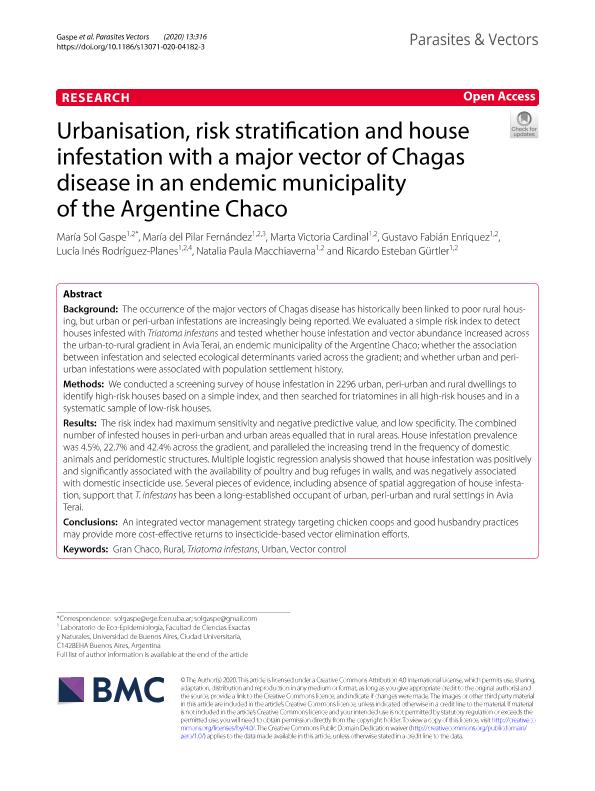Artículo
Urbanisation, risk stratification and house infestation with a major vector of Chagas disease in an endemic municipality of the Argentine Chaco
Gaspe, Maria Sol ; Fernandez, Maria del Pilar
; Fernandez, Maria del Pilar ; Cardinal, Marta Victoria
; Cardinal, Marta Victoria ; Enriquez, Gustavo Fabián
; Enriquez, Gustavo Fabián ; Rodríguez Planes, Lucía Inés
; Rodríguez Planes, Lucía Inés ; Macchiaverna, Natalia Paula
; Macchiaverna, Natalia Paula ; Gurtler, Ricardo Esteban
; Gurtler, Ricardo Esteban
 ; Fernandez, Maria del Pilar
; Fernandez, Maria del Pilar ; Cardinal, Marta Victoria
; Cardinal, Marta Victoria ; Enriquez, Gustavo Fabián
; Enriquez, Gustavo Fabián ; Rodríguez Planes, Lucía Inés
; Rodríguez Planes, Lucía Inés ; Macchiaverna, Natalia Paula
; Macchiaverna, Natalia Paula ; Gurtler, Ricardo Esteban
; Gurtler, Ricardo Esteban
Fecha de publicación:
06/2020
Editorial:
BioMed Central
Revista:
Parasites and Vectors
ISSN:
1756-3305
Idioma:
Inglés
Tipo de recurso:
Artículo publicado
Clasificación temática:
Resumen
Background: The occurrence of the major vectors of Chagas disease has historically been linked to poor rural housing, but urban or peri-urban infestations are increasingly being reported. We evaluated a simple risk index to detect houses infested with Triatoma infestans and tested whether house infestation and vector abundance increased across the urban-to-rural gradient in Avia Terai, an endemic municipality of the Argentine Chaco; whether the association between infestation and selected ecological determinants varied across the gradient; and whether urban and peri-urban infestations were associated with population settlement history. Methods: We conducted a screening survey of house infestation in 2296 urban, peri-urban and rural dwellings to identify high-risk houses based on a simple index, and then searched for triatomines in all high-risk houses and in a systematic sample of low-risk houses. Results: The risk index had maximum sensitivity and negative predictive value, and low specificity. The combined number of infested houses in peri-urban and urban areas equalled that in rural areas. House infestation prevalence was 4.5%, 22.7% and 42.4% across the gradient, and paralleled the increasing trend in the frequency of domestic animals and peridomestic structures. Multiple logistic regression analysis showed that house infestation was positively and significantly associated with the availability of poultry and bug refuges in walls, and was negatively associated with domestic insecticide use. Several pieces of evidence, including absence of spatial aggregation of house infestation, support that T. infestans has been a long-established occupant of urban, peri-urban and rural settings in Avia Terai. Conclusions: An integrated vector management strategy targeting chicken coops and good husbandry practices may provide more cost-effective returns to insecticide-based vector elimination efforts.
Palabras clave:
GRAN CHACO
,
RURAL
,
TRIATOMA INFESTANS
,
URBAN
,
VECTOR CONTROL
Archivos asociados
Licencia
Identificadores
Colecciones
Articulos(CADIC)
Articulos de CENTRO AUSTRAL DE INVESTIGACIONES CIENTIFICAS
Articulos de CENTRO AUSTRAL DE INVESTIGACIONES CIENTIFICAS
Articulos(IEGEBA)
Articulos de INSTITUTO DE ECOLOGIA, GENETICA Y EVOLUCION DE BS. AS
Articulos de INSTITUTO DE ECOLOGIA, GENETICA Y EVOLUCION DE BS. AS
Citación
Gaspe, Maria Sol; Fernandez, Maria del Pilar; Cardinal, Marta Victoria; Enriquez, Gustavo Fabián; Rodríguez Planes, Lucía Inés; et al.; Urbanisation, risk stratification and house infestation with a major vector of Chagas disease in an endemic municipality of the Argentine Chaco; BioMed Central; Parasites and Vectors; 13; 1; 6-2020; 1-14
Compartir
Altmétricas



